Inez Z. Koller – Tünde Minorics – Ákos Németh: Means of Visual and Linguistic Representation in Strengthening Community Identity
DOI szám: https://doi.org/10.64606/ksz.2025104Cikk letöltése: pdf
2025-10-01

Abstract: This study explores the impact of visual and linguistic toolkits of the Hungarian language weekly newspaper Új Magyar Képes Újság in Croatia on the local Hungarian community in minority. It pays particular attention to the visual world of the newspaper, its identifiable symbols and their role in strengthening the Hungarian community’s identity and cultural cohesion. The study is part of the research entitled “Forms and Functions of Community Culture in the Preservation of Ethnic Hungarian Consciousness in Drávaszög, Croatia” conducted by the Cultural Heritage Research Group of the University of Pécs. The research was supported by the National Institute for Culture’s Academic Grant Program for Public Culture.
Koller Z. Inez: Pécsi Tudományegyetem
Minorics Tünde: Pécsi Tudományegyetem
Németh Ákos: Pécsi Tudományegyetem
Cultural Community Spaces and Linguistic Representation
An examination of the visual elements of community spaces and the press, and as we shall see, of linguistic representation, shows that they play a significant role in reinforcing community/ethnic identity. In the use of visual tools in the weekly Új Magyar Képes Újság and in the use of visual tools in community spaces, the identifiable symbols of the visual world and their role in strengthening community identity and cultural cohesion are of particular importance. Equally important, but as yet untapped, is the potential of linguistic representation in shaping regional identity, which, through the elements of poetry and prose that live on - or are brought to life again - links the past with the present, offering an opportunity for future generations to identify with it.
As with the visual reception, the social reception of literary works can best be imagined as a process of communication, in which cultural institutions provide public spaces where information can be exchanged between creators and recipients. As Attila Thimár puts it, "An institution is anything that, even if any or all of its members or units change, can continue to function according to the rules that can be discovered, that is, it can continue to perform the function it has assigned to itself in communication with society and the representation assigned to this function." (Thimár 2001:91).
The most important institutions of literature include literary societies and organisations, journals, publishers, institutions of patronage (funders, prizes), and the celebration of literary life (Balajthy, Bódi & Szirák 2021: 15-20). The institutions, which initially exist in parallel, form a system as literary life develops, which sooner or later covers a whole geo-cultural entity, and new actors entering the scene must also define their place and role in relation to it (Thimár 2001: 93).
The war that broke out in 1991 was one of the first to shatter the vital institutional system in the occupied territory. Those institutions which could have played a decisive role in the survival and development of the intellectual life of Hungarians were abolished or withered away, or their scope of activity was reduced: the activities of organisations became impossible, information was hampered, the educational system fell apart, and the churches found it difficult to develop their activities (Mák 1997).
The lack of continuity in intellectual life and the recurrent experience of interruption may justify Ferenc Kontra's statement that, even today, instead of the Croatian Hungarian literature would form an organic continuity, it is more appropriate to speak of Hungarian literature in Croatia, in the context of the triadic unity of space-time-action (Kontra 2011:8).
The concept of region in historical geography is defined by Robin Butlin as "a classificatory and practical tool that characterises and identifies the common cultural and economic features of changing communities for different purposes and at different times, both in local and wider spatial contexts" (Butlin 1990:2). According to the British social scientist, regional identities have been gaining strength in the countries of Western Europe since the late 18th century. Literature proved to be one of the most important expressions of these identities, as it was able to represent a region with its specific ways of life, customs, values and local traditions.
This indicates that the erosion of the Hungarian ethnic communities in Croatia typically begins with the decline in the number of native speakers of Hungarian. In this situation, in addition to the family, mother-tongue school and religious life emphasised by Károly Lábadi (Lábadi 2008:13.), the role of Hungarian-language education, including the institutional system of literature, which passes on elements of identity through language, is crucial for the upbringing and preservation of new generations of Hungarian-speaking audiences. It is reasonable to assume that the preservation - or revitalization - of literary literacy in the mother tongue also means the preservation of Hungarian identity.
Molnár Ljubić's finding applies beyond the press of ethnic minorities to minority literature as a whole: "The reader of a minority press belongs to a community, through it he strengthens his identity. Its advantage over education in the mother tongue is that it can combat assimilation in the long term. In other words, a minority newspaper can continue to operate even when all Hungarian schools have closed." (Molnár Ljubić 2014: 44)
The identity-mediating and identity-affirming function of mother tongue literature is indicated by the fact that it is responsible for the dissemination of symbolic content, community values and a standardised ethnic language linked to ethnic identity, and thus a determinant of belonging to the community. "Heidegger called language the house of being ("das Haus des Seins"). The Hungarian language and literature written in Hungarian is the house of Hungarian being", writes András Görömbei (2000: 10).
Communicating with mother tongue literature can ensure a lifetime of ethnic community socialisation for its readers. The growing process of mother tongue loss among Hungarians in Croatia is therefore a particularly alarming phenomenon. At the same time, the situation is also an opportunity, as there is a reason to believe that there would be greater demand for Hungarian-language cultural opportunities among groups who (still) cling to their Hungarian identity but whose mother tongue is no longer Hungarian, if they were more effectively adapted to their changing needs. Even today, the success of literary communication is increasingly dependent on the ability to adapt the encoding of messages to the changing conditions of a cultural space that is becoming multilingual, on the one hand, and digitalisation and "secondary literacy" (Ong, 1982), on the other. This, in turn, has a significant impact on the current literary-cultural institutional system and its functioning.
The need for change may be justified by the fact that many of the chronic problems of the Hungarian community across the border (including Croatia), which are linguistically closed and isolated from the literary/cultural field of the motherland, could be overcome by making cultural content available online, preferably in multilingual form. On the other hand, addressing the "Z-generation" youth (and even younger ones), who constitute the reserve of Hungarians living beyond the borders, and getting the messages of Hungarian literature across to them would be doomed to failure without the use of digital channels (above all social media).
There are many works of 19th-20th century Croatian Hungarian literature that can still make fascinating reading for many (e.g. the diaries of Gedeon Ács, the short stories of Kornél Dezső Újlaki, the essays of Júlia Baranyai, the memoirs of János N. Dunai) - many of which have become accessible thanks to the volume edited by Ferenc Kontra (Kontra 2011). These works, as well as works by contemporary Drávaszög writers-poets, could be made into digital audio-book-like adaptations read by members of local theatre companies and uploaded to popular video-sharing sites, reaching a wide audience across borders. Hungarian teachers in Croatian public schools could also integrate them into their curricula.
There would certainly be a case for expanding analogue terrestrial Hungarian-language broadcasting, especially to reach older members of the Hungarian minority - but the focus for Hungarian minority newsrooms should clearly be on producing digital content that is in fact freely available from anywhere in the world. Podcast programmes featuring young creators of literature and the arts in their own language could be a good way of attracting the attention of their peers.
Finally, the widespread dissemination of mother tongue education and literary literacy can hardly succeed without the active involvement of the 'top literary institutions'. The Department of Hungarian Language and Literature at the J. J. Strossmayer University of Sciences and Humanities in Eszék (Osijek) is one such basic institution of Hungarian literature in Croatia. Although the Department has a social media platform in Hungarian (https://www.facebook.com/magyartanszekeszek), it may seem a shortcoming that it does not have a separate website in Hungarian, where the wider professional public in the Carpathian Basin could find information about the main events of the Department and the current research of its staff.
The renewal of Rovátkák, published by the Croatian Hungarian Democratic Community, seems to be an exciting and ambitious initiative, transforming the publication from a yearbook into a real literary and cultural journal, whose themes appeal to the entire Hungarian community and Croatian native readers interested in Hungarian literature. At present, however, there is a great lack of a website behind the printed journal, which has a limited circulation and is only rarely accessible to the literary public in Hungary, where the content of previous issues could be retrieved and which could play an important role in the creation of an intellectual workshop around the journal.
There is now growing evidence that the increasingly accessible global tools of digital communication: social media, content-sharing platforms and other online platforms can also serve to reinforce local identities, as the online content consumer, freed from the physical constraints of cyberspace, no longer faces geographical barriers to identification. In the words of Stuart Hall:
"With the 'global' effect comes an interest in the 'local'. [...] So rather than thinking that the global will replace the local, it would be more accurate to say that a new division of labour is emerging between the global and the local. The 'local' should not, of course, be confused with older identities that are firmly rooted in well-defined landscapes. Rather, it all works within the logic of globalisation. However, it seems unlikely that globalisation will simply destroy national identities. It is more likely to create new 'global' and new 'local' identities in parallel." (Hall 1997: 79)
In the age of the World Wide Web, local and regional identities can live far from home: in Budapest, Munich and New York, one can remain a Drávaszög Hungarian. If the actors of the Hungarian-language literary and cultural fields can make use of the opportunities offered, then there is a chance that the "Home in the Heights" dreamed up by Gyula Illyés can be realized in cyberspace.
The Weekly at the Service of Community Identity
Founded in 1991, Új Magyar Képes Újság is part of the Hungarian-language press for Hungarians living beyond the borders of Hungary, that plays a significant role in the life of Hungarian communities, not only in providing information, but also in building community and preserving cultural identity. In Transylvania (Romania), daily newspapers are published under the titles of Krónika (Transylvania-wide, 1999-), Szabadság (Cluj-Napoca, 1989-), Hargita Népe (Harghita County, 1989-), Háromszék (Sepiszentgyörgy, 1989-) and Népújság (Târgu Mures, 1924-1940, 1989-), each with a distribution of a few thousand copies. In Felvidék (Slovakia), Új Szó (1949-) is a daily with a larger distribution, Szabad Újság (1991-) is a political, economic and cultural weekly, and Vasárnap magazine (1991-) is a weekly focusing on Christian values. In Transcarpathia (Ukraine), the daily newspaper Kárpáti Igaz Szó (Uzhhorod, 1967-) covers news from the region, while Kárpátalja (1920-) provides more comprehensive coverage for the Hungarian community in Transcarpathia. In Vojvodina region (Serbia), the Magyar Szó (1944-) reports daily news, the Hét Nap (1946-) is a weekly newspaper providing local news, and the Családi Kör (1995-) covers cultural topics for Hungarian-speaking readers. In the Muravian region (Slovenia), the weekly Népújság (1945-) provides news. In Burgenland (Austria), the Felsőpulyai Hírmondó (1983-) is a weekly newspaper summarising news for the Hungarian community in Burgenland, while Őrség (1991-) is a quarterly cultural magazine.
Historical Background and Starting Points for Analysis
A detailed history of the Új Magyar Képes Újság from Mónika Molnár Ljubić can be found in the book edited by Judit Gasparics and Gábor Ruda, which provides an insight into the life of the Hungarian press in Croatia (2014). The circumstances and changes of the weekly newspaper's operation are described in a historical context in Ferenc Mák's book A horvátországi magyar sajtó 1914-1989 (2014). In addition, the laws concerning ethnic minorities in Croatia provide an important starting point for understanding the operational framework of the newspaper and, more broadly, the Hungarian-language press in Croatia. Independent and autonomous since 1991, Croatia has framed and declared the rights of the ethnic minorities living on its territory from the very beginning of its existence. It has granted broad cultural autonomy and civil rights for its ethnic minorities. In 1992, Croatia signed a bilateral cooperation treaty with Hungary, in which the two countries mutually guaranteed the freedom of expression and preservation of identity for their ethnic communities, the free use of their mother tongue and the prohibition of discrimination based on their ethnic identity - the Hungarian community in Croatia and the Croatian community in Hungary. On the other hand, Ildikó Novák's analysis published in the Hungarian Studies Bulletin was an important starting point for the study of visual culture that focuses on the visuality of the Hungarian journal culture in Vojvodina (Novák 2017: 111). As a basis for the analysis of political symbols, we relied on an earlier study on the ethnicity discourse of the Hungarian political elite in parliamentary speeches (Koller 2024).
The Magyar Képes Újság was first established in 1952 and since 1999 it has continued to operate under the name Új Magyar Képes Újság (Molnár Ljubić 2014: 47). Following the South Slavic War, Hungarian organisations were also reorganised. The first publisher of the weekly newspaper, the Association of Hungarians in Croatia, was dissolved and replaced by the Democratic Community of Hungarians in Croatia and the Association of Hungarian Associations, the former reviving the Új Magyar Képes Újság and the latter creating the Magyar Napló in 2001. The Új Magyar Képes Újság struggled with financial difficulties for years while the Croatian state repeatedly withdrew support from it and other Hungarian-language publishers (Mák 2014). In the early 2000s, the circulation of the weekly newspaper was around 1,000, due to scarce financial resources and competition with other Hungarian language newspapers, which affected the quality of its appearance and shaping. Since 2010, however, it has received regular support from the state budget of the Republic of Croatia on the one hand, and from the Hungarian Bethlen Gábor Fund on the other. Its current editor-in-chief is Tünde Micheli.
The basic premise of this study is that minority press has an additional function beyond providing news. It holds a given minority community together, reinforces its identity, while at the same time preventing the assimilationist environment of the majority society from taking hold. „Elements of cultural heritage such as language, folklore, traditions are sometimes seen as manifestations that are capable of blocking the goals of creating national level political and public administrational unity. In fact, understanding diverse cultural ways of thinking and values based on ethnicity benefits both the local and the national integrity of communities” (Koller et al., 2022: 6). It works mainly through linguistic and visual means, their amplification and coded ideological messages. The minority press primarily follows the daily life of a community in its mother tongue, reporting on events that directly and indirectly shape the life of the community, while also reporting on national and homeland-related news that may have an impact on the life of the minority community (Molnár Ljubić 2014: 46).
As Novák points out in her analysis of the Hungarian press in Vojvodina, the prevalence of visual culture is the most characteristic feature of our present. "We live in a world of dumping visual content, yet the interpretation of images cannot be called easy", quoting Mirzoeff, she adds, "visualization makes linguistic discourse "more comprehensible, faster and more efficient" (Novák 2017:112.) This can be traced in the development of the Új Magyar Képes Újság. The size of the logo has increased spectacularly compared to the early years, with only headlines framing the front page. In the newspaper itself, the number of articles has been reduced in the 2000s, the text section is more concise and more space is given to images (Molnár Ljubić 2014: 47), moreover, short embedded videos have appeared on the online interface, which clearly fits in with the general trend of tabloidisation.
Visual Analysis
The visual analysis of the study examines the visual presentation of the newspaper, highlighting the photos of issues 1-31 of volume XXVIII, which are mostly related to the calendar events of the Hungarian community in Croatia. This analysis is compared with the Molnár Ljubić study, which used a similar analytical approach and examined 15 issues from 1988 to 2009. During this period, turbulent political-social changes, the separation from the Hungarian community in Vojvodina and the faltering funding had an impact on the formal appearance of the newspaper. During the period under review, the size of the newspaper increased, it became slightly elongated, the colour - black and white edition, the thickness of the covers and the size of the covers varied. Initially, the cover photos did not serve to attract attention and were not linked to the articles in the newspaper until 2005. The newspaper's logo gradually moved to a more prominent position, first in the front page header and now occupying a third of the front page.
"The most important feature of tabloids is their populism, the fact that they appeal to the widest audience, conveying their thoughts and feelings." (Császi 2003: 157) In the process of tabloidisation, the means of publicity, especially the newspapers, are less and less responsive to the cognitive interpretative skills and needs of the audience, focusing instead on emotional needs and the ease of reception.
Tabloidisation is the phenomenon of tabloid news over-dominating the quality press. The content is varying, popular, easily digestible news and columns are replacing lengthy analyses and essays, there are fewer and fewer technical terms and foreign words in the text, while there is more slang, everyday speech. Personalisation is used, where news is packaged to highlight a particular politician or famous person, where the public role of the prominent figures is given space alongside other features of their personality, thus bringing them closer to readers. (Szabó 2011: 79) In the case of the Új Magyar Képes Újság, we can speak of a hybrid tabloidization in terms of content. The first, larger half of the newspaper covers political, social and cultural topics. From page 14 onwards, however, the tabloid takes over. Business advice, recipes, children's corner, fashion, beauty, health, horoscopes, book and film reviews, motoring news, jokes, TV programmes (Hungarian channels that broadcast with a reach out to the region or are available for specific cable TV subsribers), household tips, free classifieds, crossword puzzles.
Between 1988 and 2009, the number of articles and the number of words in the articles steadily decreased, with a parallel increase in font size and spacing, as well as the use of eye-catching titles, more pictures and graphics. Over the period under review, articles based purely on text have gradually been accompanied by a greater use of images, mainly photos. The vast majority of the images depicted people, at first ordinary people, and then increasingly well-known portraits of public figures or crowd or group pictures associated with an event (Molnár Ljubić, 2014: 49-51). The visual elements studied in 2024, already give a clear dominance to imagery over text-based information. The front page features three images and headlines from the newspaper content. The title is in white letters in an orange band. The front pages of the newspaper feature top Hungarian politicians (Viktor Orbán, Péter Szijjártó, Árpád Potápi, etc.) and the main leaders of the Hungarian community in Croatia (mostly Róbert Jankovics). Two Hungarian national holidays stand out among the events featured: the National Day of March 15 and the King St. Stephen Day on August 20. These national holidays are also the biggest celebrations in Hungary, symbolising national unity, and the Hungarians of Drávaszög attach great importance to them. Local folk traditions include cock knock (kakasütés), dancing the maypole, paprika, grape and corn harvest festivals. In addition to these, thematic events are organised on the Day of Hungarian Culture in several Hungarian settlements, such as Bellye (Bilje) and Laskó (Lug).
Cultural and Political Symbols
The emergence of cultural and political symbols can be linked to a socio-political context in which the emphasis on the belonging of a given community is considered essential for the survival and development of the community. As a means of emphasis, these symbols "have both a conceptual and an emotional content, and are emotionally overloaded... beyond themselves, they have many other meanings" (Koller 2024:148). In representing social reality, they are capable of evoking stronger emotions than the simple communication of information. The analysis of symbols consists of four steps, 1) identification of the primary meaning, 2) interpretation of the additional meaning(s) superimposed on it, 3) separation of the unifying and opposing meanings, and 4) description of the changed meaning, content, form and function of the symbol (Kapitány & Kapitány 2008:13) Symbols are usually not used independently but in association with a specific social context and are associated with a specific value system. Their role may change, their significance may increase or decrease.
Among the visual elements of the Új Magyar Képes Újság, we analysed, on the one hand, those cultural and political symbols that were frequently seen in almost all the issues examined, namely colour symbolism and folk costumes. I also examined two other unique symbols: the area-specific reworking of pieces of the Hungarian cards, which symbolise the cultural cohesion of all Hungarians and are easily understood by all Hungarians, and the cock knock, a folk tradition at the time of carnivals that is strongly alive in the folk customs of the Hungarians in Croatia. It is perhaps not surprising that the colours of the Hungarian national flag, red, white and green, appear together in the framing of many of the photos and in the separation of sections, and that red and especially green also define the image of the whole newspaper. However, these colours also dominate in the photos published, usually depicting cultural programmes, especially in the case of Hungarian Culture Day events. These colours symbolise the connection with the Hungarian nation as a whole. The reader can easily identify who the newspaper is for and about. The use of these colours is more significant for the Hungarian minority than for the Hungarian majority in Hungary, and therefore they are not only used on national holidays, but also in the presentation of many other cultural events, or even on the sports wear of the Várdaróc Football Club. In addition to the national colours, there is one more colour that appears prominently in the newspaper, and that is orange. For those familiar with political parties and their identifier colours in Hungary, this is an easily decodable colour, the colour of Fidesz. In addition to the basic colour of the front page and the main menu of the online version of the newspaper, this colour is more typically seen in articles and images on political topics, but not only in relation to the Hungarian government or Fidesz politicians, but also in the publications of the Hungarian Democratic Community of Croatia (HDMK) or in the call for village meetings. For example, the party campaigned in the 2023 election campaign with a very similar slogan to Fidesz in 2022: "Only the HDMK". The strong presence of the colour orange is a likely indicator of Fidesz's strong presence in the life of Hungarians in Croatia, as evidenced by reports of financial support for political and cultural organisations. Thus, in addition to being a national colour representing cultural cohesion, orange also represents political cohesion.
In addition to the distinctive colours, there are many pictures of people dressed in traditional costumes. There is no style of folk art specific to the region in these photos. We are just as likely to see schematic red, white and green costumes as the floral motifs typical of Kalocsa embroidery: roses, lilies, carnations, bellflowers, daisies, pansies, tulips, starflowers, violets, forget-me-nots. Their function is the same: to preserve the Hungarian cultural heritage. And the use of folk costumes is facilitated by many Hungarian cultural programmes, socialising members of the Hungarian community from an early age to a sense of belonging, which both enhances the meaning of cultural programmes and personal participation and provides added personal meaning.
1. picture: People's Costume Day, 2024
(Source: Új Magyar Képes Újság online)
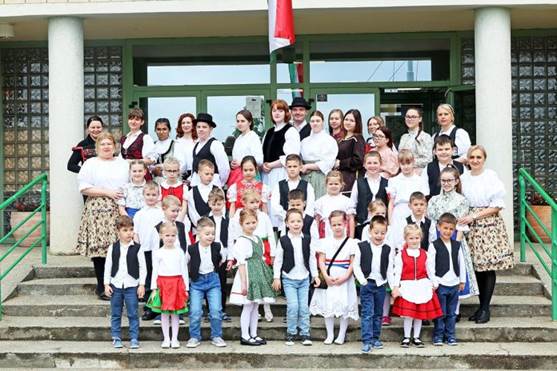
2. picture: Wreath-laying ceremony on 15 March, 2024
(Source: Új Magyar Képes Újság online)
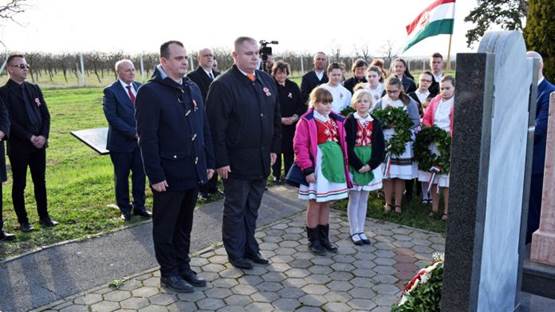
3. picture: Maypole unfurling in Újbezdán, 2024.
(Source: Új Magyar Képes Újság online)
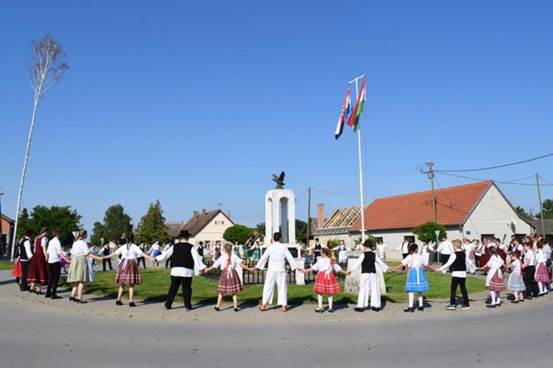
Moving on from the idea of political cohesion, we come to the reworking of the Hungarian card, which is an example of a condensed symbol with additional meaning. It emphasises the characteristic feature of symbols that they can have constantly changing, dynamic meanings. It means something quite different to a Hungarian but outside observer, while it means more than the original meaning to the inhabitants of Sepse (Kotlina), Pélmonostor (Beli Manastir), Kórógy (Korođ) and Vukovár (Vukovar), who can feel a greater pride in their Hungarianness when they see these cards.
4. picture: Souvenirs of the Democratic Community of Hungarians in Croatia:
a Hungarian card, a cap depicting Hungarian settlements as aces on a Hungarian card, 2024.
(Source: photo by Tünde Minorics)
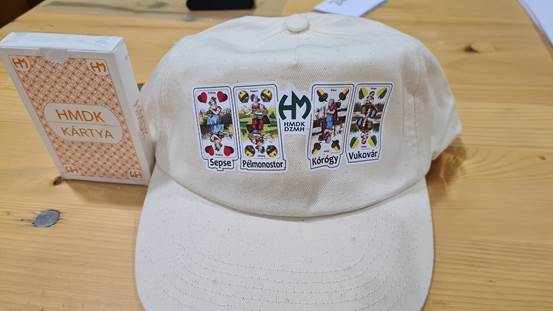
The „cock knock” is present in Hungary and in many other Hungarian settlements across the border. But it is most popular in the villages of the Hungarian community in Croatia. The Hungarian Cultural Association of Várdaróc has been organizing the event for 24 years now, and in 2013 it was included in the Hungarian Values Register of Hungary Abroad.
5. picture: Várdaróc cock knock, 2016.
(Source: Új Magyar Képes Újság online)
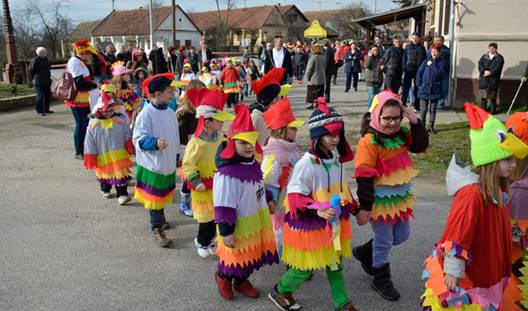
6. picture: Várdaróc cock knock, 2021.
(Source: Új Magyar Képes Újság online)
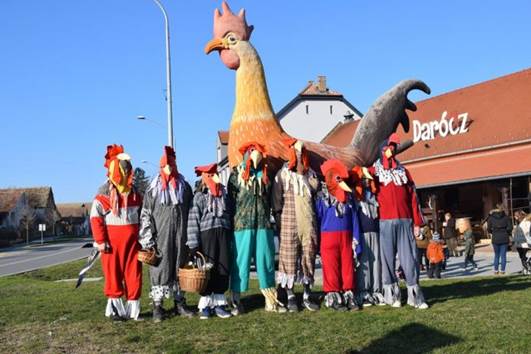
Cock knocking was originally a carnival-time folk custom, during which young people would blindfolded knock on a buried cock head or live cock on a meat rack, and whoever hit the target would get their wish, possibly signalling a wedding in the near future. This tradition is nowadays also used but in a gentler form (with plush cocks) to connect smaller Hungarian settlements, to strengthen the common Hungarian consciousness and the sense of common destiny of the youth, and therefore has a meaning-filtering, changing character.
Conclusion
Visual content usually not only enriches the reader's experience, but also serves to convey information. In the case of the Új Magyar Képes Újság, it serves to preserve and strengthen the identity of the Croatian Hungarians by preserving important moments in the life of their community, many of which depict the cultivation of the community's cultural heritage and its highlights. The Molnár Ljubić study points out that the Új Magyar Képes Újság has a weaker role in preserving identity in areas where the Croatian Hungarians live in higher density (Osijek-Baranya County, Eastern Slavonia). This is explained by the fact that in this area the Hungarian minority has access to other Hungarian-language media, due to the Hungarian-language kindergartens, schools and the proximity of the border. For this reason, the weekly is considered to be of much greater importance in more isolated Hungarian-inhabited areas such as Szentlászló (Laslovo) or Vukovár (Vukovar). We, on the other hand, believe that the lack of easy access and a fragmented information function is well compensated by culturally focused news stories for a targeted readership, which offer a sense of belonging emphasised by symbols and thus strengthen all Hungarians in Croatia as members of a community with a regional identity. Thus, it is not proximity, but the same cultural context that is more decisive.
A kutatási folyamatot és a tanulmány elkészítését a Nemzeti Művelődési Intézet Közművelődési Tudományos Kutatási Program Kutatócsoportok számára alprogramja támogatta.
Sources:
- Balajthy, Á., Bódi, K. & Szirák, P. (2021). A kortárs magyar irodalom. Debrecen: Debreceni Egyetemi Kiadó. https://doi.org/10.5484/9789636150761
- Butlin, R. (1990). Történeti földrajz, regionális identitás és kulturális régiók összehasonlító elemzése. Tér és Társadalom, 4(3-4), 1-11. https://doi.org/10.17649/TET.4.3-4.179
- Császi, L. (2003). A média tabloidizációja és a nyilvánosság átalakulása: A Clinton-Flowers-botrány tanulságai. Politikatudományi Szemle, 12(2), 157-172.
- Görömbei, A. (2000). A kisebbségi magyarság és irodalma az ezredvégen. In: Bitskey, I. & Görömbei, A. (szerk.), Nemzetiségi magyar irodalmak az ezredvégen (pp. 7-28). Debrecen: Kossuth Egyetemi Kiadó.
- Hall, S. (1997). A kulturális identitásról. In: Feischmidt, M. (szerk.), Multikulturalizmus (pp. 60-85). Budapest: Osiris–Láthatatlan Kollégium.
- Kapitány, Á. & Kapitány, G. (2008). Résztvevő megfigyelés a saját társadalomban – korszakok szimbolikája. In: Kézdi Nagy, G. (szerk.), A magyar kulturális antropológia története (pp. 369-410). Budapest: Nyitott Könyvműhely.
- Koller, I. Z. et al. (2022). Cross-Border Croatian Cultural Heritage and the Expertise of Community Organisers. Pécs: University of Pécs.
- Koller, I. Z. (2024). Nemzetiség és ideológia. Parlamenti beszédmódok a nemzetiségről (1990-1994). Pécs: Publikon Kiadó.
- Kontra, F. (2011). Horvátország magyar irodalma: A kezdetektől napjainkig. Osijek: HunCro.
- Lábadi, K. (2008). Élet a háború után: Etnikai, néprajzi és kulturális jelenségek a horvátországi magyarság körében az 1991-es déli szláv háború után. [Job report, OTKA]. http://real.mtak.hu/1349/1/46235_ZJ1.pdf
- Mák, F. (1997). Magyarok Horvátországban. Magyar Kisebbség, 3(3-4). https://epa.oszk.hu/02100/02169/00007/M970321.htm
- Mák, F. (2014). A horvátországi magyar sajtó 1914–1989. In: Apró, I. & Paál, V. (szerk.), A határon túli magyar sajtó Trianontól a XX. század végéig: Fejezetek a magyar sajtószabadság történetéből (pp. 237-278). Budapest: Médiatudományi Intézet.
- Molnár Ljubić, M. (2014). A horvátországi magyar sajtó és a „Képes Újság”. In: Gasparics, J. & Ruda, G. (szerk.), Drávaszög és Szlavónia: Adalékok a horvátországi magyarok nyelvéhez és kultúrájához (pp. 44-52). Pilisvörösvár: Muravidék Baráti Kör Kulturális Egyesület.
- Novák, A. (2017). A vizualitás és textualitás viszonya a vajdasági magyar folyóiratokban. Hungarológiai Közlemények, 18(3), 110-119. https://doi.org/10.19090/hk.2017.3.110-119
- Ong, W. J. (1982). Orality and Literacy: The Technologizing of the World. London–New York: Methuen.
- Szabó, G. (2011). Vox Pop: A populáris média politikaképe a 2010-es országgyűlési választási kampány idején. Politikatudományi Szemle, 20(1), 75-94.
- Thimár, A. (2001). „A társaság állapotja”: Egy irodalmi intézménytörténeti adatbázis megtervezésének tanulságai. Irodalomtörténeti Közlemények, 105(1-2), 90-106.
- Új Magyar Képes Újság Volume XXVIII, Issues 1-31.
